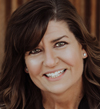November 16, 2021
 This is the third in a series of guest blogs by the 2021-22 Michigan Regional Teachers of the Year. Theresa Ziegeler is a social studies teacher at Macatawa Bay Middle School in West Ottawa Public Schools.
This is the third in a series of guest blogs by the 2021-22 Michigan Regional Teachers of the Year. Theresa Ziegeler is a social studies teacher at Macatawa Bay Middle School in West Ottawa Public Schools.
How often are words added to the Merriam-Webster dictionary? In my lifetime, I can think of a few that didn’t exist in my K-12 school years but became common in my adulthood. “Selfie” being one; “hashtag,” “tweet” and “retweet,” “youtuber” and likely any other word related to technology. You guessed it, I am old. Like, graduated from high school, completed a bachelor’s and master’s degree both without the use of a personal computer old! And look at me now, writing a blog. (BTW, 455 new words were added to the Merriam-Webster dictionary for October 2021 alone.)
Times change. Growth happens. We want that and wouldn’t be the advanced society that we are if things always stayed the same. So my question for you is this: Why were people so quick to express their desire to go “back to normal,” referring to the way education was before March 13, 2020, when we learned new words like “COVID,” “social distancing” and “asynchronous teaching”?
This has led to the 2021-2022 school year beginning as a mash of both “what we learned” from the COVID shut down and our desire for “normalcy.” In my opinion, merging the two creates a dissonance between eagerness for educational growth that collides with yearning for pre-COVID times. We lose some perspective if we go back to “the way things were.” The COVID-19 pandemic abruptly and fiercely changed teaching and learning. It changed the setting of our schools, the service of our schools, the engagement of our families and the characteristics of our learners.
Pivoting to virtual school brought inequities to the surface and challenged the status quo of access to things many take for granted, like wifi and devices. Change happened, adjustments are still being made to close technology gaps, and the setting of our schools no longer has to be brick and mortar. But is there an option for
every learner?
Teaching reading, writing and arithmetic, while important, did not remain the sole purpose of our schools. Servicing families with food insecurities and community resources for emotional support became just as important as traditional lessons. The spotlight shining on the needs of families is bright. Schools truly are the heart of a community. Some funding has come through to keep programs that began during the COVID shutdown going. The need for more funding is being heard, but are changemakers listening?
Creating ways for parents and schools to communicate without barriers of physicality or language has been a keeper on both sides. Using virtual platforms, the conversations have become accessible for all in regards to schedules, translation services and wrap-around providers. But does every stakeholder know it?
Our children learned a lot about themselves in the past year and a half as well. Some found pathways to be seen and heard in an online platform whereas an in-person setting inhibited them. Some found that the ideal world of their dreams of not going to school wasn’t at all what they’d thought it would be. Some found grit and resilience; some found effort and motivation far beyond reach. And now, we have them ALL in a school year without its own identity. But how do we meet ALL of their needs? What are the lessons learned during COVID that still resulted in student growth? Believe it or not, my school has the data to prove it happened.
Teachers are at a breaking point. The teaching profession is facing a critical shortage with the potential of detrimental effects. Maybe the pandemic was sending the message that “normal” wasn’t working and getting back to it isn’t the way forward. What are the COVID keeps that should force change to the future of education?
While the term “COVID keeps” probably won't make it into Webster's dictionary, it has, by the grace of my administrator, made it into the teacher lexicon of my building. But its definition varies between educators. For me, I would like it to have smaller class sizes and longer learning periods. For others, it might be project-based learning and the elimination of letter grades.
Keep the thoughts and questions coming, move forward with your actions and embrace the hard work of change as fully as you did when the pandemic hit. Decisions in education today will not only make a difference for our students; the right decisions will change the world.
What are your COVID keeps?